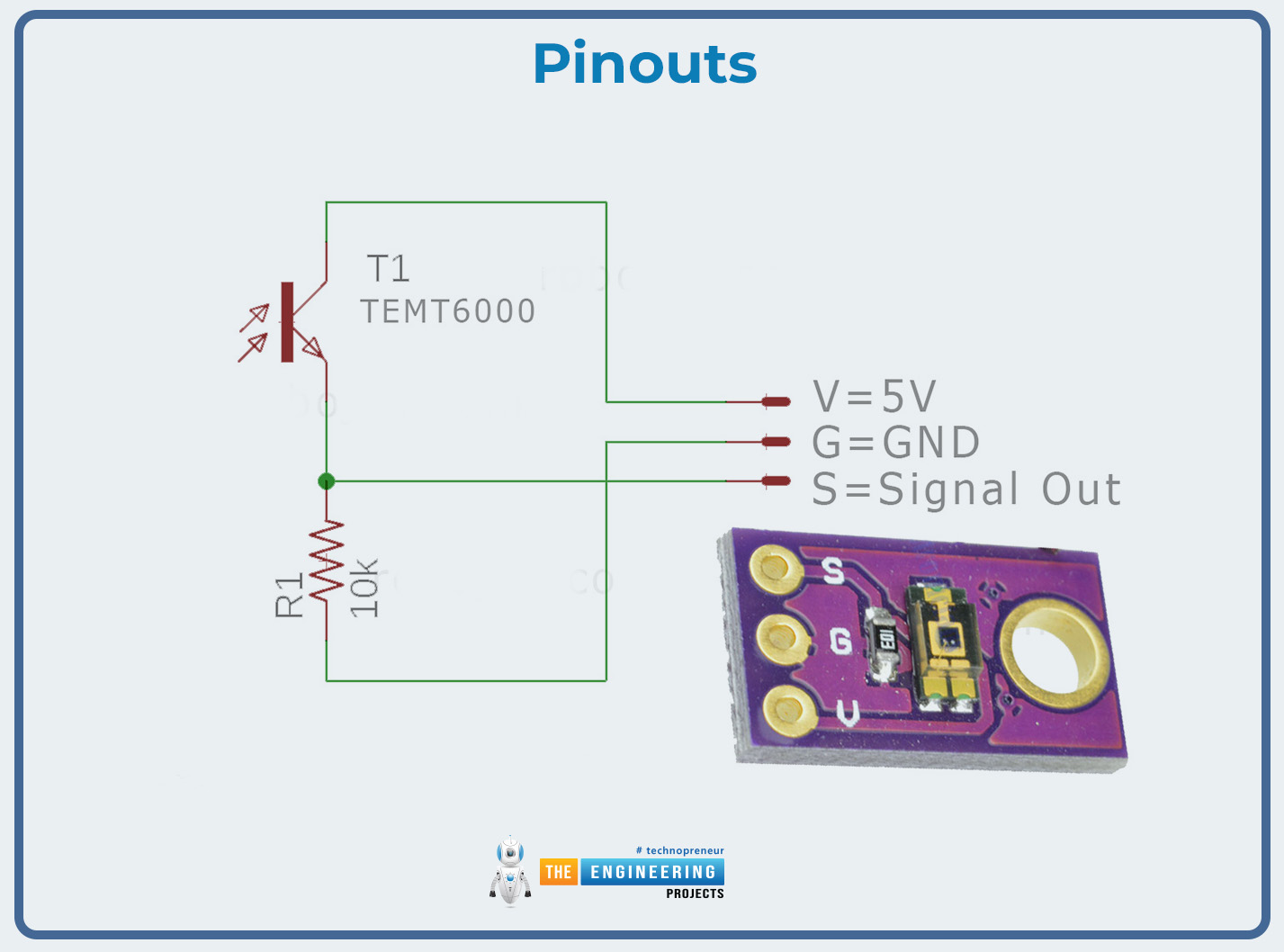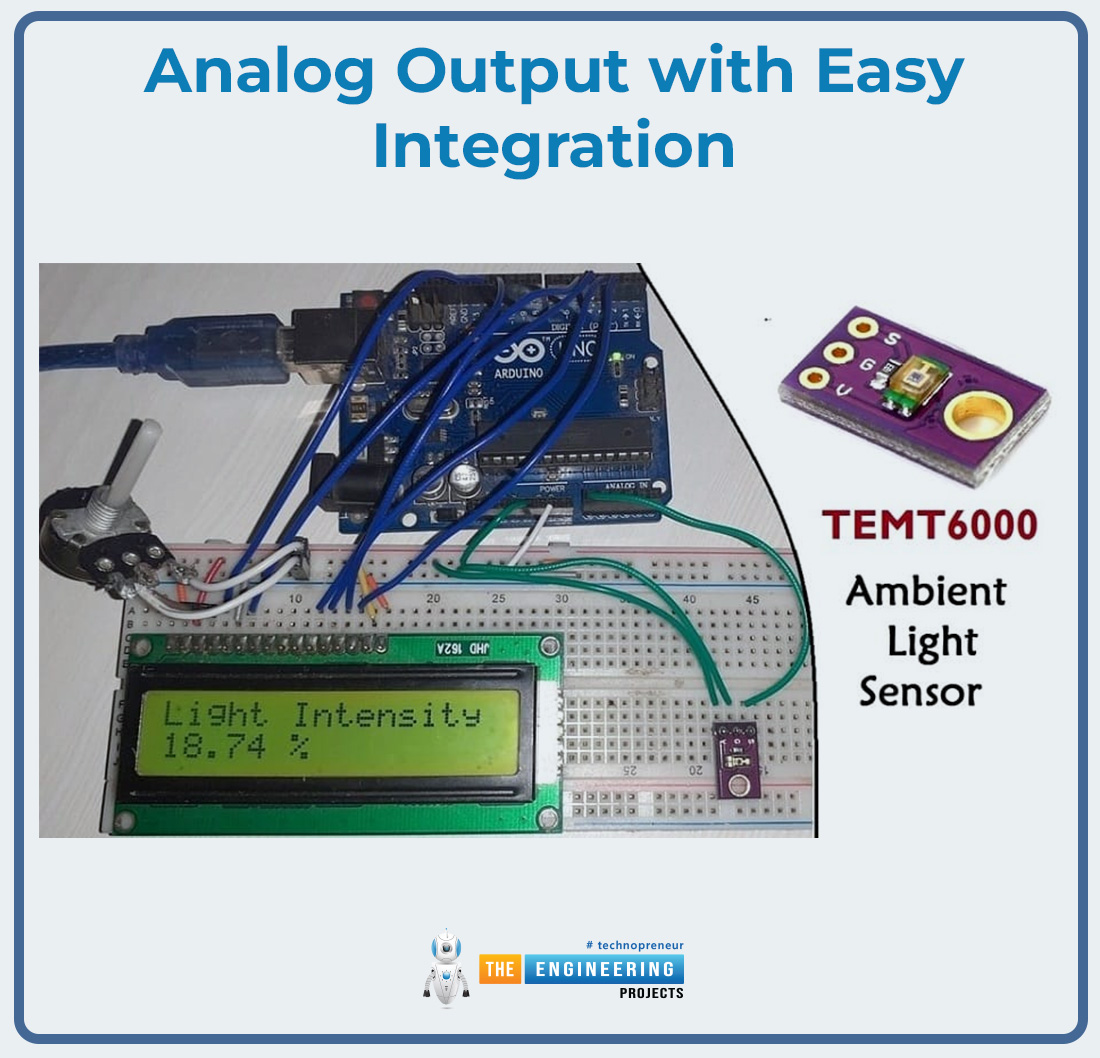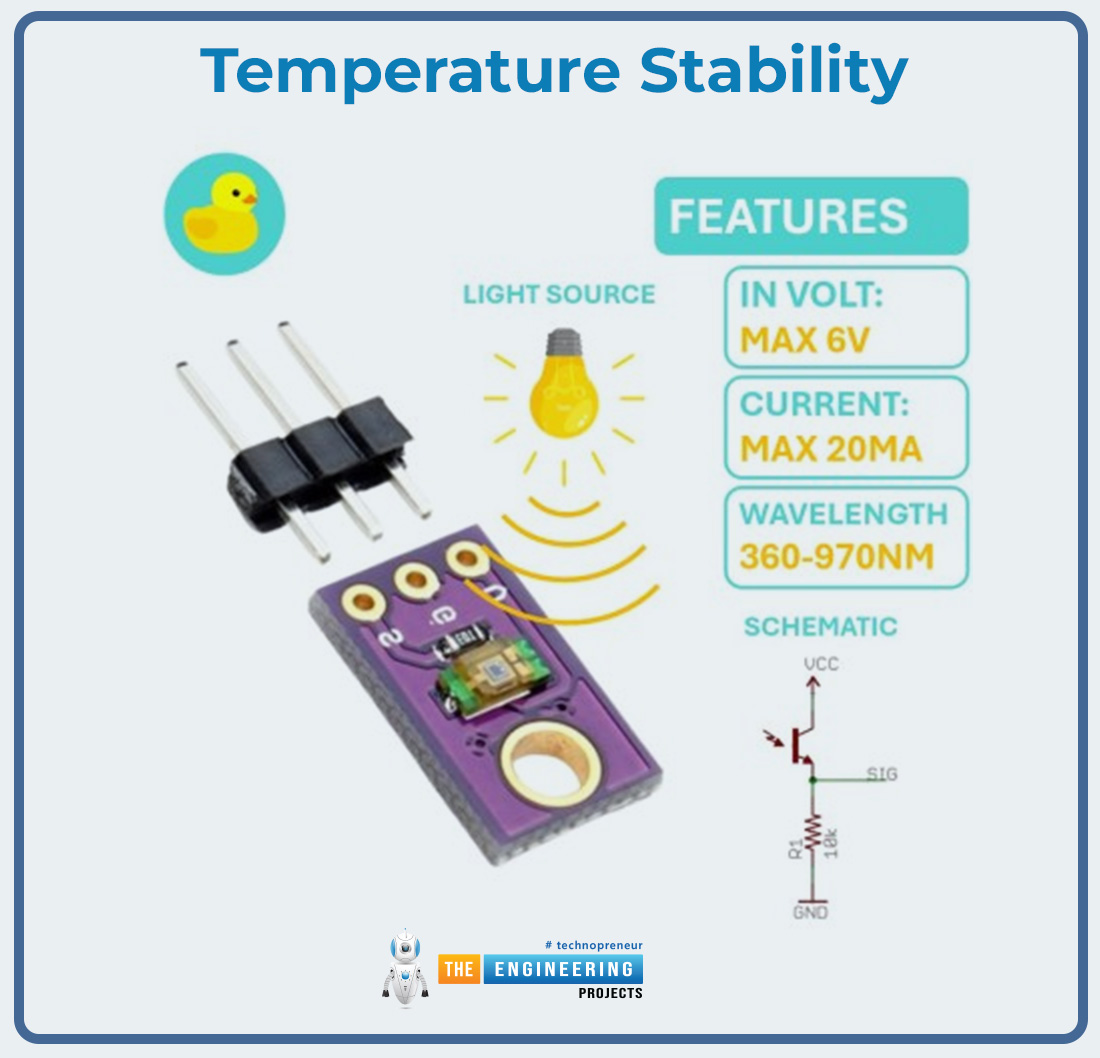
Hi readers! I hope you are fine and spending each day learning more about technology. Today, the subject of discussion is the TEMT6000 Ambient Light Sensor. It may be something you were aware of or something new and unique.
The TEMT6000 is a high-performance ambient light sensor designed to accurately measure the intensity of visible light and provide an analog output that is directly proportional to the light level. It is instrumental in applications where light levels need to be detected, such as backlight adjustment in displays, smart lighting systems, and energy-efficient electronics.
The TEMT6000 works by responding like a phototransistor, which detects how much light is in a light range of 400 to 800 nm spectrum ranges. It responds to changeable light intensity and produces an analogous changing voltage that can be relatively simply connected to microcontrollers, to name a few systems that further process the changing electrical output.
This ambient light sensor is highly sensitive and wide-ranging in its detection range, from dim to bright lighting. Its low power consumption makes it suitable for use in a battery-operated device or other energy-saving system. TEMT6000's small size makes it very easy to integrate into designs where available space is at a minimum, such as portable electronics and wearables.
TEMT6000 is widely used in devices such as smartphones, tablets, and smart home systems, where it automatically adjusts screen brightness, controls lighting, and improves user experience while saving energy.
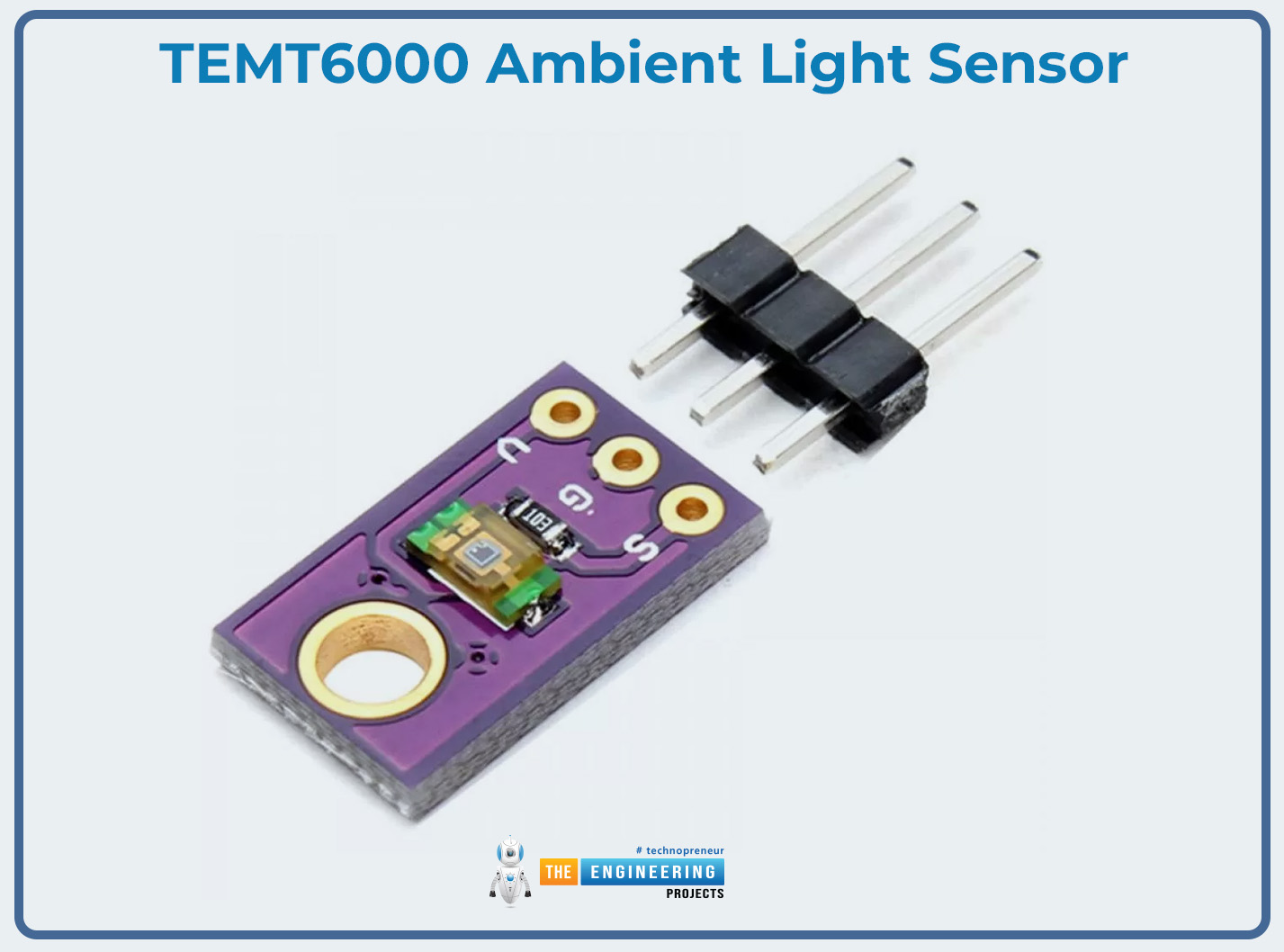
This article will discover its introduction, features and significations, working and principle, pinouts, datasheet, and applications. Let's start:
Introduction:
- The TEMT6000 is an ambient light sensor with a high-performance level of detecting visible light intensity. It has an analog output proportional to the detected level of light. It operates between 400 nm and 800 nm, which are the visible light spectrum frequencies, thus simulating how the human eye responds to light. It finds applications where automatic light control is necessary, such as display backlighting.
- Used in smart lighting systems and energy-efficient electronic devices.
- Low power consumption, which makes the component suitable for battery-operated and portable devices.
- Highly sensitive to light; used to detect light over a significant range from dim to very bright conditions.
- It can be integrated into consumer electronic devices such as smartphones tablets and wearables where automatic brightness adjustment is allowed.
- It plays an important role in smart home systems and is used in lighting management to save energy.
- Its compact size will help for easy integration with the very constrained designs.
- Its improvement makes the user experience better because of adjustments according to the light that exists in the ambient.
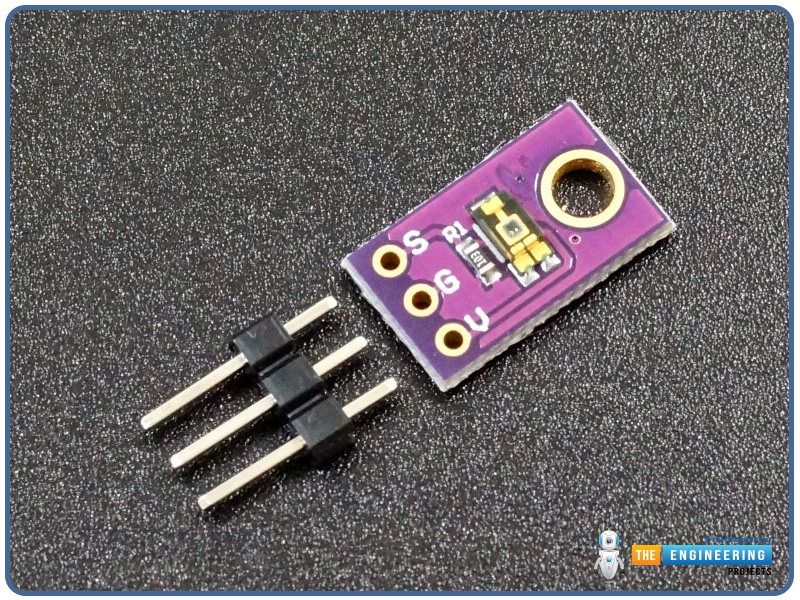
Datasheet:
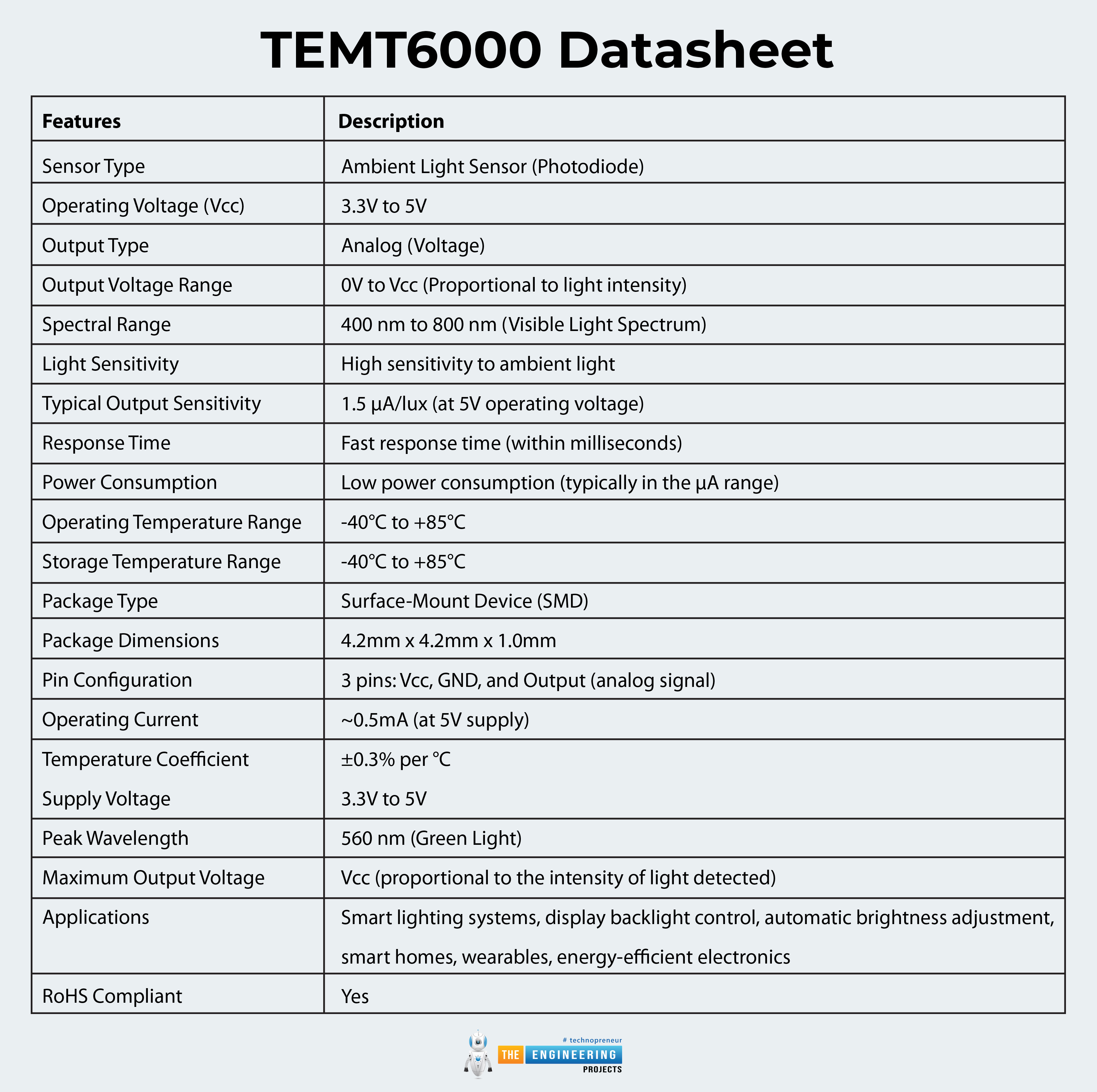
Features |
Description |
Sensor Type |
Ambient Light Sensor (Photodiode) |
Operating Voltage (Vcc) |
3.3V to 5V |
Output Type |
Analog (Voltage) |
Output Voltage Range |
0V to Vcc (Proportional to light intensity) |
Spectral Range |
400 nm to 800 nm (Visible Light Spectrum) |
Light Sensitivity |
High sensitivity to ambient light |
Typical Output Sensitivity |
1.5 µA/lux (at 5V operating voltage) |
Response Time |
Fast response time (within milliseconds) |
Power Consumption |
Low power consumption (typically in the µA range) |
Operating Temperature Range |
-40°C to +85°C |
Storage Temperature Range |
-40°C to +85°C |
Package Type |
Surface-Mount Device (SMD) |
Package Dimensions |
4.2mm x 4.2mm x 1.0mm |
Pin Configuration |
3 pins: Vcc, GND, and Output (analog signal) |
Operating Current |
~0.5mA (at 5V supply) |
Temperature Coefficient |
±0.3% per °C |
Supply Voltage |
3.3V to 5V |
Peak Wavelength |
560 nm (Green Light) |
Maximum Output Voltage |
Vcc (proportional to the intensity of light detected) |
Applications |
Smart lighting systems, display backlight control, automatic brightness adjustment, smart homes, wearables, energy-efficient electronics |
RoHS Compliant |
Yes |
Key Features:
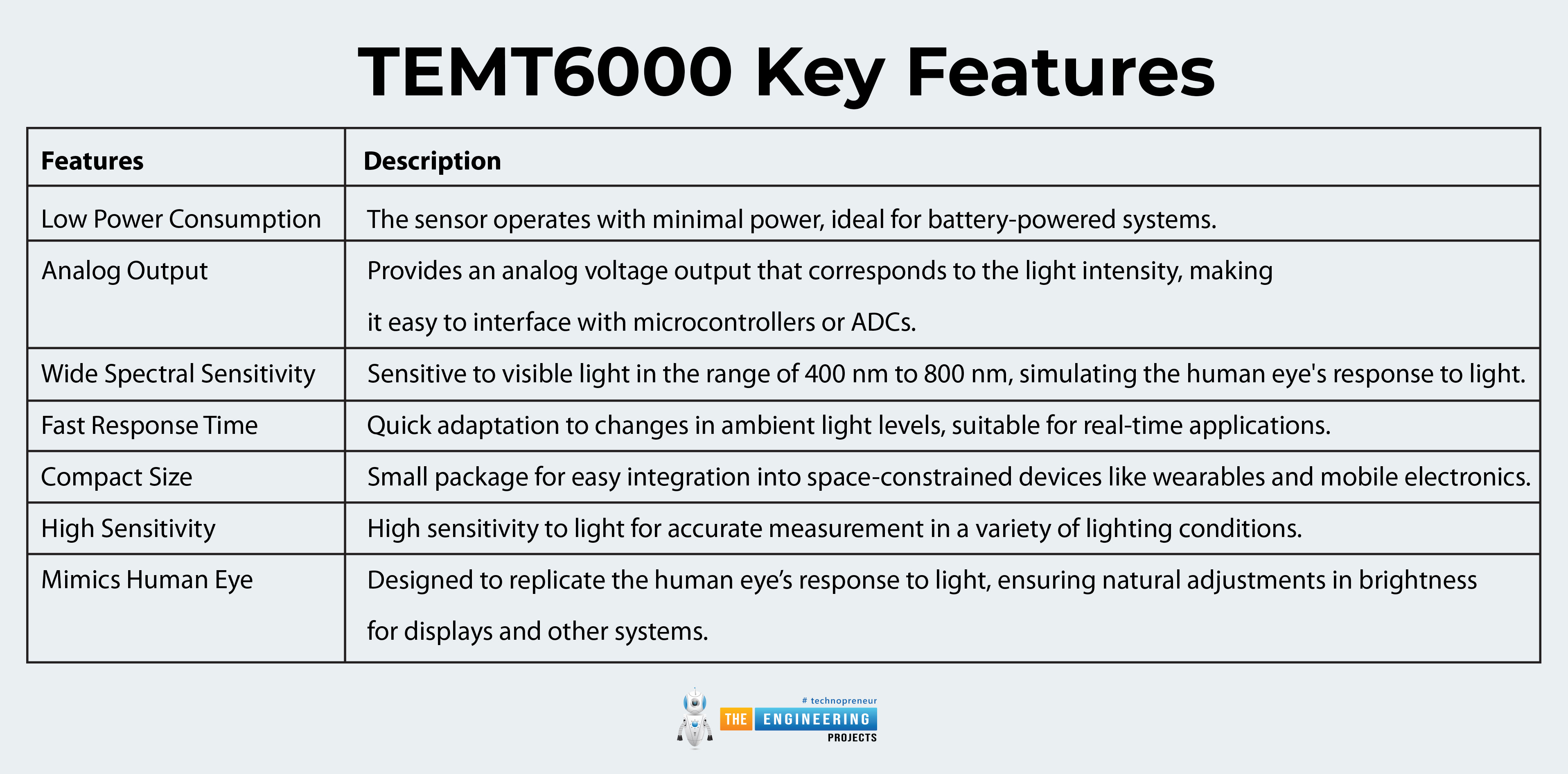
Features |
Description |
Low Power Consumption |
The sensor operates with minimal power, ideal for battery-powered systems. |
Analog Output |
Provides an analog voltage output that corresponds to the light intensity, making it easy to interface with microcontrollers or ADCs. |
Wide Spectral Sensitivity |
Sensitive to visible light in the range of 400 nm to 800 nm, simulating the human eye's response to light. |
Fast Response Time |
Quick adaptation to changes in ambient light levels, suitable for real-time applications. |
Compact Size |
Small package for easy integration into space-constrained devices like wearables and mobile electronics. |
High Sensitivity |
High sensitivity to light for accurate measurement in a variety of lighting conditions. |
Mimics Human Eye |
Designed to replicate the human eye’s response to light, ensuring natural adjustments in brightness for displays and other systems. |
Pinouts:
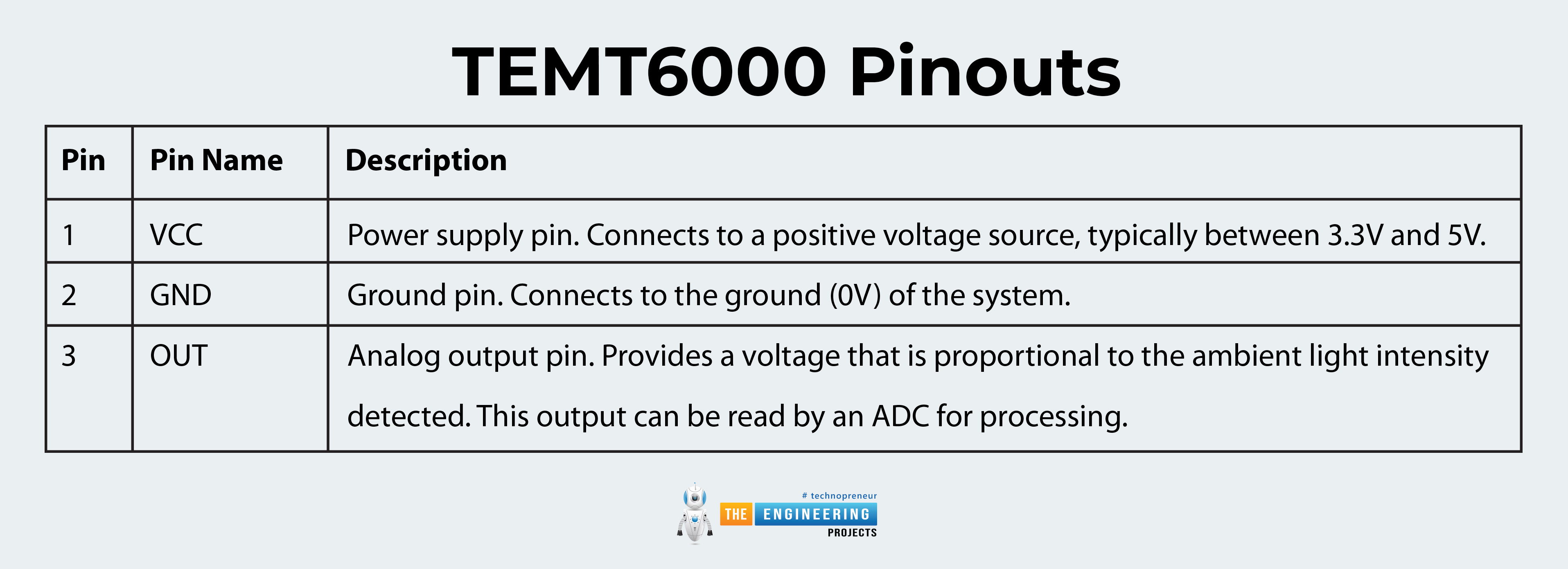
Pin |
Pin Name |
Description |
1 |
VCC |
Power supply pin. Connects to a positive voltage source, typically between 3.3V and 5V. |
2 |
GND |
Ground pin. Connects to the ground (0V) of the system. |
3 |
OUT |
Analog output pin. Provides a voltage that is proportional to the ambient light intensity detected. This output can be read by an ADC for processing. |
Pin Functionality:
Vcc (Pin 1):
This is the input power to the sensor. The operating voltage is usually around 3.3V to 5V, so it powers the internal circuitry of the TEMT6000.
GND (Pin 2):
The GND pin must be tied to the system's GND to complete the circuit.
OUT (Pin 3):
The analog out pin provides a variable voltage dependent on the direct proportion relationship with the ambient light the sensor detects. This output could be interfaced to ADC for microcontrollers or another processing unit for more accurate measurements by converting the voltage. At higher light intensity, an increased output voltage is encountered.
Features:
Wide Light Sensitivity Range:
The TEMT6000 is extremely light-sensitive with a spectral range between 400 nm and 800 nm. It covers the whole spectrum that ranges visible to humans, making the sensor applicable in areas requiring it to simulate human observation of light intensity. Since this sensor can be able to precisely measure the light across a wide range, it's ideal for detecting all different lighting conditions, be it dimly lit or very bright.
Analog Output:
One of the key features of the TEMT6000 is its analog output, which gives a voltage proportional to the ambient light intensity. As the light level increases, so does the output voltage, allowing for easy interfacing with microcontrollers or ADCs for processing and decision-making. This simple output makes it easy to integrate into systems requiring real-time adjustments based on light intensity, such as backlight control for displays.
Low Power Consumption:
The TEMT6000 is optimized to run at low power consumption. It is well suited for battery-operated devices and energy-saving systems. The sensor has a minimal current draw, thus it will not consume too much of the portable devices' battery life. This feature is very important in mobile devices, wearables, smart lighting, and IoT applications, which primarily consider energy efficiency.
High Sensitivity to Light:
It offers very high sensitivity to ambient light. The TEMT6000 light sensor can detect light at both low and high intensities over a wide range of measurements. This sensitivity enables it to be responsive to changes in lighting and ensure correct measurement for applications such as display backlighting, smart lighting, and energy management systems.
Simple, User-Friendly Design:
With its simple three-pin configuration (Vcc, GND, and OUT), the TEMT6000 is very easy to use and integrate. It operates with minimal external components, which simplifies the design process for engineers. The analog output directly correlates to the ambient light level, making it easy for developers to read and process the data through a microcontroller. This simplicity makes the TEMT6000 a cost-effective choice for light-sensing applications.
Fast Response Time:
The TEMT6000 sensor reacts very fast to changes in ambient light conditions. The fast response ensures that the sensor can measure fluctuating light levels in real-time. This is very beneficial for dynamic environments where lighting conditions change rapidly, such as in outdoor applications or smart homes where lighting adjustments are made automatically based on ambient conditions.
Cost-Effective:
The TEMT6000 is a low-cost ambient light sensing solution due to its simplicity and low power consumption. It is an excellent performer at a competitive price, thus ideal for manufacturers who would like to integrate light-sensing capabilities into their products without raising costs much. This feature is advantageous in mass-produced consumer electronics, where cost reduction is a primary consideration.
Compact Size and Easy Integration:
The TEMT6000 has a compact form factor that can easily be integrated into small or space-constrained designs. The small size makes it perfect for applications where real estate is limited, such as portable consumer electronics like smartphones, tablets, wearables, and cameras. The sensor is also available in a surface-mount package (SMD) which further enhances its integration into compact systems.
Mimics Human Eye Reaction:
The sensor can react like the human eye would light, hence great for applications that require it to detect light in ways mimicking human vision. The feature is critical when such applications include the adjustment of screen or display brightness. That way, the device has a way of changing itself to adapt to its surroundings in a way that the human user finds natural. This human-eye mimicry ensures that the sensor works effectively in a range of real-world scenarios.
Temperature Stability:
The TEMT6000 gives a stable response across a wide range of operating temperatures. This feature makes the sensor reliable for performance in a variety of environmental conditions, from indoor applications to outdoor environments that experience temperature fluctuations. Its ability to perform steadily under changing temperatures means the device will remain accurate and dependable over time.
Working Principle:
Photodiode Behavior:
The photodiode is a type of semiconductor device that reacts sensitively to light and thus forms the core component in TEMT6000. Its working principle is about changing light energy into electricity using an electrical current generated with moving electrons in the presence of exciting light on the surface. The magnitude of generated currents is proportional to light intensities falling on the surface.
The sensor then converts the electrical current into a corresponding voltage output through its internal circuitry. The output voltage is an analog signal proportional to the intensity of the ambient light, such that as the light intensity increases, the output voltage proportionally increases, and vice versa.
Internal Amplification and Voltage Conversion:
The photocurrent of the photodiode in TEMT6000 is relatively low. In order to convert this current into an analog usable voltage signal, the sensor has an internal amplifier circuit. This amplifier takes the small photocurrent from the photodiode and boosts it up to a level that can be read by external components like microcontrollers or ADCs.
The TEMT6000 integrates all internal circuitry to produce a linear voltage that varies directly concerning light intensity. When light increases, the output also increases; thus, in easy steps, it shows an easily correlate-able quantity for lighting conditions within that environment. Under low lights, it would typically register between 0V and high (bright lights) supply levels are usually set at 5V.
Proportional Output:
The output signal of TEMT6000 is proportional to the intensity of the light that falls on the sensor. That is, when the intensity of ambient light is increased, the current from the photodiode is increased as well, leading to a higher output voltage. However, when the ambient light is reduced, the photocurrent decreases, and so is the output voltage.
Since the sensor's output voltage varies directly proportional to the light intensity, the sensor gives a definite and measurable response toward change in light levels. Thus, for example, it can be expected that if placed under a bright light source, the sensor would generate a near-supply output voltage, while in darkness, the output voltage should come close to 0V.
The output of a sensor is easily readable by any microcontroller or ADC, and its voltage can further be processed to control devices or even change the brightness of some displays, control lighting ON/OFF states, and optimize energy consumption, among other things.
Temperature Compensation:
Another very critical influencing factor on the performance of light sensors is temperature. The response of a photodiode to light may be affected due to fluctuating temperatures. Therefore, TEMT6000 features an inherent temperature compensation for stable operation within a wide range of conditions.
The TEMT6000 works through temperature compensation circuitry by adjusting the light response of the sensor in real-time and compensates for all the changes caused by variations in temperature. This ensures the output voltage is stable and accurate despite changes in external temperatures. Thus, the sensor becomes reliable to be used in multiple environmental conditions.
Wide Spectral Sensitivity:
The TEMT6000 is designed to sense light in the visible spectrum (approximately 400 nm to 800 nm), corresponding to the wavelengths of visible light to the human eye. This makes it an ideal candidate for applications where human perception of light intensity is crucial, such as backlighting adjustments for displays, energy-efficient lighting, and smart home systems.
The photodiode in TEMT6000 is made to be most sensitive and responsive to the wavelengths visible to the human eye, particularly around the 560nm wavelength of green light wherein the sensor is most responsive. The sensitivity of this sensor to the human eyeball perception of light ensures a proper response from the sensor which is aligned with that of human perception of the same light, thus best suited for applications wherein the intensity of light applied has to match human anticipation.
Analog Output with Easy Integration:
The output of the TEMT6000 is analog. Analog output makes it easy to integrate with devices that will read analog signals such as microcontrollers, ADCs, or any system demanding real-time light information. The analog nature of the output allows smooth and continuous controls of devices like backlit displays, streetlights, and automatic lighting systems for which precise and real-time light intensity is indispensable.
The analog output of the sensor makes it a very simple device to integrate into the system, without requiring the processing of digital signals that might be complicated. Such simplicity in integration is why TEMT6000 has found its application in the fields of energy-efficient electronics and smart systems.
Applications:
Display Backlight Control: Manages the brightness of display screens according to ambient lighting conditions to enhance visibility as well as save energy.
Smart Lighting Systems: Auto-controls lighting in smart homes and buildings to optimize energy utilization.
Energy-Efficient Electronics: Controls brightness in the smartphone, wearables, and other devices to increase their battery life.
Automatic Brightness Adjustment: Applied in many different consumer electronics to enhance a user's experience by the automatic adjustment of brightness.
Wearable Devices: Controls and integrates into wearables in terms of adjusting display brightness based on surrounding light conditions.
Outdoor Lighting Systems: Controlling streetlights and signage; it adjusts the light levels as daylight is available.
Conclusion:
The TEMT6000 Ambient Light Sensor is an efficient and versatile solution for measuring ambient light levels. Due to its high sensitivity to visible light, the sensor is perfectly suited for various applications, such as backlight control for displays, smart lighting systems, and energy-efficient electronics. Its analog output provides an easy-to-integrate interface that enables devices to automatically adjust brightness in response to ambient light levels.
Key features such as temperature compensation and wide spectral sensitivity make the TEMT6000 reliable for performance in a wide range of conditions, making it perfect for indoor and outdoor applications. Low power consumption with compact design makes it perfect for portable and battery-powered devices, extending battery life and optimizing energy use.
Whether in smart homes, wearables, or energy-saving systems, the **TEMT6000** adapts to light conditions, enhancing user experience and contributing to power efficiency. Simplicity and reliability have made it a prime choice for many industries looking to achieve precise light sensing and control.



